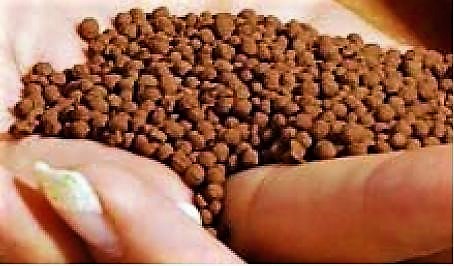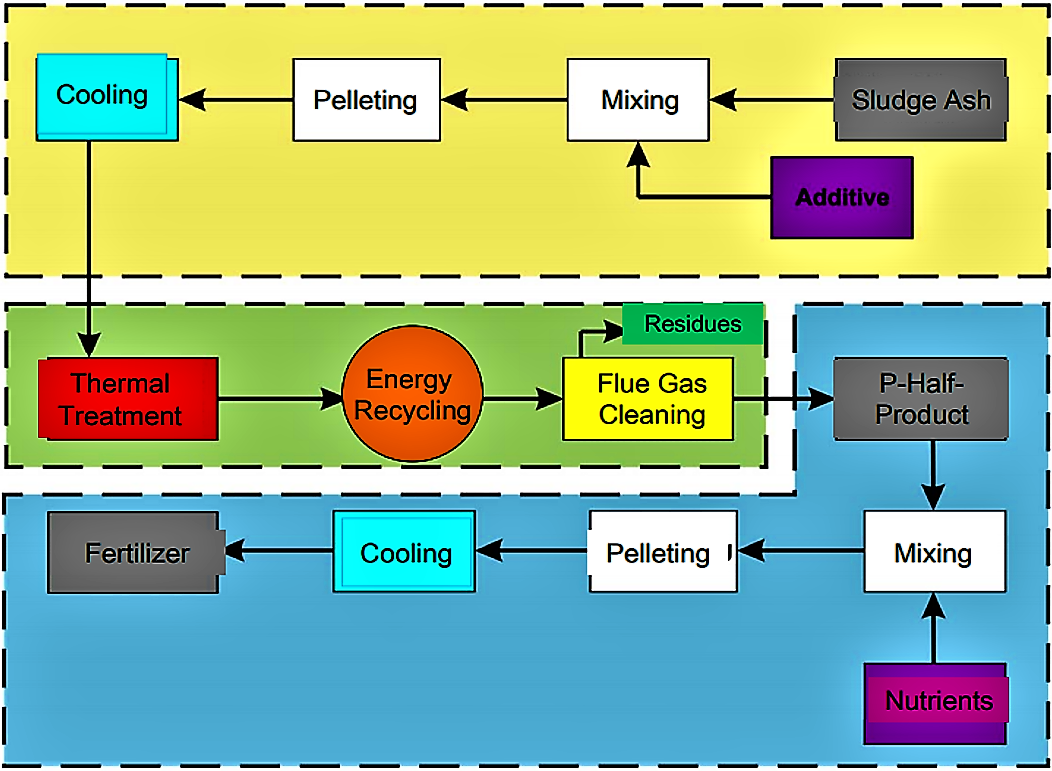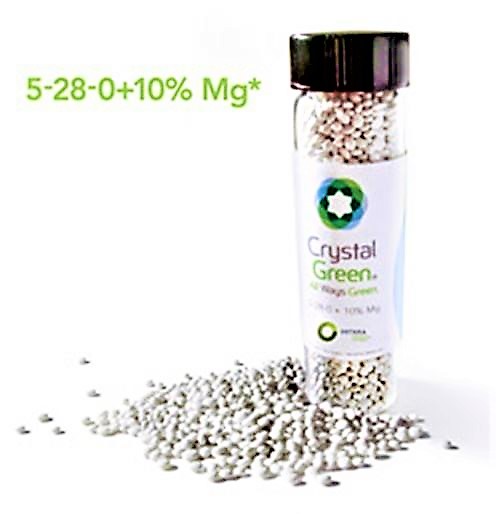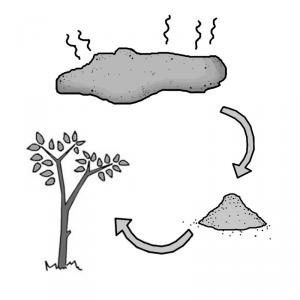Executive Summary
There exist several new processes, which aim at recover the nutrients, mainly phosphorus from sewage sludge. ASH DEC for instance refers to N-P-K fertiliser, which is produced based on a sewage sludge ash containing a lot of phosphorus enriched with other nutrients such as nitrogen, potassium or sulphur by using the patented ASH DEC technology. The thermo-chemical process has undergone extensive testing in a semi-industrial pilot plant since 2008 and has now achieved industrial maturity. The produced phosphate fertilisers contains significantly lower levels of contaminants than conventional mineral fertilisers and has proven to be even more effective in terms of dry mass yield and plant uptake in some soils. A similar product is called Crystal Green. It can be produced in a unit directly integrated in a wastewater treatment facility and produces a solid granular fertiliser.
| In | Out |
|---|---|
Fertiliser |
Introduction
As fertiliser prices raise and phosphorus resources decline, the recover of nutrients, mainly phosphorus from wastewater and sewage sludge sees increasing interest (see also peak phosphorous). Today, there exists already several processes, at small or large scale to recover these nutrients the most often in form of struvite, also called Magnesium Ammonium Phosphate Hexahydrate (MAP) (see also struvite and struvite precipitation from urine). The production and use of such local and renewable source for fertiliser can help to optimise the water and nutrient cycle.
The patented ASH DEC technology of the ASH DEC Umwelt AG (Austria) is one of many ways to regain nutrients lost in incineration sewage sludge and to make them available to agriculture. In comparison to other processes, the ASH DEC process has been sufficiently researched so that it is now applicable at industrial scale.
The ASH DEC fertiliser and process
The thermo-chemical process removes the toxic heavy metals from the ash and induces chemical nutrient compounds that plants can easily take up from the soils. With its process, ASH DEC produces a multi-nutrient fertiliser out of sewage sludge ash, which meets all relevant parameters of national regulations in Europe. With regard to its cadmium concentrations, it beats mineral phosphate fertilisers by one order of magnitude. During the process, toxic substances are evaporated and concentrated in the flue gas cleaning system, whereas the nutrients become plant-available. The process recovers primary (P, K), secondary (Ca) and trace nutrients (Mg, Fe, S). Particularly P reaches concentrations comparable to standard single phosphate fertilisers.

Explaining the process
- First raw sewage sludge is incinerated.
- Then, ash and harmless chlorine donors are mixed and compacted in a pellet press. Reagents are dosed in accordance with ash quality as well as legal and final-product requirements.
- The pellets are fed to a thermal reactor and exposed for about 20 minutes to a temperature of 1.000° C. At this temperature, up to 99% of the target metals - usually mercury, cadmium, lead, zinc and copper - react with the additives and evaporate.
- 98% of the input ash arrives in form of P-rich granules without toxic substances. 2% of the input ash is retained in the air pollution control system in form of a metal concentrate.
- To produce fertilisers that meet the requirements of soils and crops, the P-raw product is enriched with other nutrients such as nitrogen, potassium, sulphur or an additional portion of phosphorus.

Crystal Green (Ostara Inc.)
(Adapted from OSTARA 2011)
Crystal Green refers to NPK fertiliser produced from the effluent of wastewater treatment plants in a process called Pearl®. The process can be integrated directly into a treatment system and helps also to prevent unwanted precipitation in pipes etc. It is based on controlled chemical precipitation in a fluidised bed reactor that recovers struvite in the form of highly pure crystalline pellets. The nutrient-rich feed streams (liquid fractions of sludge are first mixed with magnesium chloride and, if necessary, sodium hydroxide and then fed into the reactor where the struvite “seeds” e begin to form. These seeds grow in diameter until they reach the desired size of about 1-3.5 mm. In a municipal wastewater treatment plant, up to 90 % of the phosphorus and 40 % of the ammonia load is removed from sludge dewatering liquid using this process and the resulting product is marketed as a commercial fertiliser called Crystal Green®. The fertiliser is adaptable to any types of turf, field-grown nursery stock and high-demand phosphorous crops. Because this fertiliser is solid, the risk of leaching or runoff is significantly reduced.

In general, incinerators that combust sewage sludge, meat and bone meal, digestion residues from biogas facilities and similar material with usually no or little co-combustion of industrial residues qualify for nutrient recovery to produce fertilisers. Preferred plant locations are close to incinerators of reasonable combustion capacity.
Yet, it must be mentioned that this technology is very high-tech and highly energy intensive. It may be a good technology in highly industrialised countries where laws prohibit the use of treated sewage sludge in agriculture — it can then help to close the nutrient loop. Yet, there are other methodologies that allow for a much simpler and less energy intensive nutrient recovery than for instance burning sludge (that usually has a very high moisture content). The technology requires significant financial investment, though ASH TEC is willing to contribute to this.
Industrial Process and Pilot Plant
This presentation gives a brief overview on the ASH DEC technology and processes and the first ASH DEC pilot plant.
ASH DEC (2008): Industrial Process and Pilot Plant. PDF Presentation. Vienna: ASH DEC Umwelt AG. [Accessed: 18.08.2010] PDFRecycling von Phosphor aus Klärschlammaschen
This presentation describes the need for recycling phosphorus and the economic sector of the enterprise. There is further information on the process and the pilot plant. Aspects of benchmark and finance are included as well as a brief description of the need for recycling phosphorous (in German).
HERMANN, L. BACHLEITNER, E. (2004): Recycling von Phosphor aus Klärschlammaschen. Vienna: ASH DEC Umwelt AG URL [Accessed: 27.05.2019]ASH DEC UMWELT AG Success Stories
This short information paper describes the development of ASH DEC Umwelt AG. The process and the product are described shortly and a few historical key figures of the enterprise’s development are mentioned (in German).
ASH DEC (2010): ASH DEC UMWELT AG Success Stories. Vienna: ASH DEC Umwelt AG. [Accessed: 17.08.2010] PDFCrystal Green
Industrial Process and Pilot Plant
This presentation gives a brief overview on the ASH DEC technology and processes and the first ASH DEC pilot plant.
ASH DEC (2008): Industrial Process and Pilot Plant. PDF Presentation. Vienna: ASH DEC Umwelt AG. [Accessed: 18.08.2010] PDFRueckgewinnung von Phosphor aus der Abwasserreinigung
The present study provides an overall perspective on technologies for the recovery of phosphorus from wastewater treatment plants and the opportunities they offer. It differs from previous work in that it not only provides technical process details, but also – and particularly – highlights the status of development, probable availability, and economic viability of the processes, providing the reader with an aid in decision making.
BAFU (2010): Rueckgewinnung von Phosphor aus der Abwasserreinigung. Bern: Department of the Environment, Transport, Energy and Communications, Switzerland (FOEN/BAFU) URL [Accessed: 27.05.2019]Nährstoffe und Verwendung von Düngern in der Landwirtschaft
These terms of references define the legal regulations in Switzerland concerning the water protection and air pollution control for the use of nutrients and fertilisers in agriculture.
BAFU ; BLW (2012): Nährstoffe und Verwendung von Düngern in der Landwirtschaft. Ein Modul der Vollzugshilfe Umweltschutz in der Landwirtschaft. Bern: Bundesamt für Umwelt (BAFU) / Bundesamt für Landwirtschaft (BLW) URL [Accessed: 27.05.2019]ASH DEC UMWELT AG Success Stories
This short information paper describes the development of ASH DEC Umwelt AG. The process and the product are described shortly and a few historical key figures of the enterprise’s development are mentioned (in German).
ASH DEC (2010): ASH DEC UMWELT AG Success Stories. Vienna: ASH DEC Umwelt AG. [Accessed: 17.08.2010] PDFP – und Naehrstoffduenger aus Klaerschlammaschen
This presentation by ASH DEC Umwelt AG describes the need for recycling phosphorous and the economic sector of the enterprise. There is further information on the process and the pilot plant. Finally, ASH DEC gives general information on their fertiliser product and explains their idea of joint operating company (in German).
ASH DEC (2008): P – und Naehrstoffduenger aus Klaerschlammaschen. Vienna: ASH DEC Umwelt AG. [Accessed: 17.08.2010] PDFFaecal Sludge Management.
This issue presents studies from different regions (Bangladesh, Cameroon, Burkina Faso) that mainly show the non-existence of faecal sludge management. Additionally, the last paper describes a new technological solution (LaDePa) for producing hygienically safe organic fertiliser from sludge from ventilated improved pit toilets (VIPs).
ECOSAN CLUB (2012): Faecal Sludge Management.. (= Sustainable Sanitation Practice , 13 ). Vienna: Ecosan Club URL [Accessed: 16.10.2012]Agriculture and Fertilizers Analysis, Lessons, Solutions
The presentation gives an overview on global trends in terms of food consumption, fertiliser needs and consumption in the agricultural sector, fertiliser prices and the potential of ‘mining’ urban phosphorus resources.
HERMANN, L. (2004): Agriculture and Fertilizers Analysis, Lessons, Solutions. Vienna: ASH DEC Umwelt AG PDFRecycling von Phosphor aus Klärschlammaschen
This presentation describes the need for recycling phosphorus and the economic sector of the enterprise. There is further information on the process and the pilot plant. Aspects of benchmark and finance are included as well as a brief description of the need for recycling phosphorous (in German).
HERMANN, L. BACHLEITNER, E. (2004): Recycling von Phosphor aus Klärschlammaschen. Vienna: ASH DEC Umwelt AG URL [Accessed: 27.05.2019]Phosphorus Recovery from Sludge in Sweden - Possibilities to meet proposed Goals in an efficient, sustainable and economical Way
Different strategies and methods to achieve the target of recovering phosphorus from sludge are discussed based on reports from the Swedish environment protection agency (SEPA) and with special emphasis on extraction of phosphate from wastewater, sludge and ash at central plants. Some possible improvements are briefly discussed, such as the use of certain comparatively clean sludge fractions and use of two-stage technology for the recovery.
HULTMAN, B. LEVLIN, E. PLAZA, E. STARK, K. (n.y): Phosphorus Recovery from Sludge in Sweden - Possibilities to meet proposed Goals in an efficient, sustainable and economical Way. URL [Accessed: 27.05.2019]Wirklich "intelligente" Phosphate
This short abstract highlights the need for recycling phosphorous as a very valuable resource and provides information on the pilot plant of ASH DEC Umwelt AG settled in Austria (in German).
NEW BUSINESS (2008): Wirklich "intelligente" Phosphate. In: New Business, Mai 2008: , 13. PDFSludge Treatment and Disposal
Sludge Treatment and Disposal is the sixth volume in the series Biological Wastewater Treatment. The book covers in a clear and informative way the sludge characteristics, production, treatment (thickening, dewatering, stabilisation, pathogens removal) and disposal (land application for agricultural purposes, sanitary landfills, landfarming and other methods). Environmental and public health issues are also fully described.
ANDREOLI, C.V. ; SPERLING, M. von ; FERNANDES, F. (2007): Sludge Treatment and Disposal. (= Biological Wastewater Treatment Series , 6 ). London: International Water Association (IWA) Publishing URL [Accessed: 27.05.2019]Biological Wastewater Treatment in Warm Climate Regions Volume 2
Biological Wastewater Treatment in Warm Climate Regions gives a state-of-the-art presentation of the science and technology of biological wastewater treatment, particularly domestic sewage. The book covers the main treatment processes used worldwide with wastewater treatment in warm climate regions given a particular emphasis where simple, affordable and sustainable solutions are required. The 55 chapters are divided into 7 parts over two volumes: Volume One (also available in the SSWM library): Introduction to wastewater characteristics, treatment and disposal; Basic principles of wastewater treatment; Stabilisation ponds; Anaerobic reactors; Volume Two: Activated sludge; Aerobic biofilm reactors; Sludge treatment and disposal.
SPERLING, M. von LEMOS CHERNICHARO, C.A. de (2005): Biological Wastewater Treatment in Warm Climate Regions Volume 2. London: International Water Association (IWA) Publishing URL [Accessed: 26.05.2019]Soil Solution Chemistry of Sewage-Sludge Incinerator Ash and Phosphate Fertiliser Amended Soil
This article investigates the potential for using soil solution chemical properties to study the consequences of recycling sewage-sludge incinerator ash on agricultural land.
BIERMAN, P. ; ROSEN, C. ; BLOOM, P. ; NATER, E. (1995): Soil Solution Chemistry of Sewage-Sludge Incinerator Ash and Phosphate Fertiliser Amended Soil. In: Journal of Environmental Quality: Volume 24 , 279-285. URL [Accessed: 27.05.2019]The Story of Phosphorus
This thesis proposes a new global goal – phosphorus security – to be integrated in the dominant research discourses and policy debates on global food security and global environmental change. Among other criteria, phosphorus security requires that phosphorus use is decoupled from environmental degradation and that farmers’ access to phosphorus is secured.
CORDELL, D. (2010): The Story of Phosphorus. (= PhD Thesis ). Linkoeping: Linkoeping University, Department of Water and Environmental Studies URL [Accessed: 17.08.2010]Outotec - Sustainable use of Earth´s natural resources
ASH DEC Umwelt AG, currently Outotec, operates manufacturing plants to recycle nutrients and metals from incineration residues. The focus of interest is the production of phosphorous-fertilisers and –raw products from sewage sludge ash with the patented ASH DEC technology.
SUSAN - Sustainable and safe re-use of municipal sewage sludge for nutrient recovery
Homepage of a the Sustainable and Safe Re-use of Municipal Sewage Sludge for Nutrient Recovery – SUSAN Project, a Specific Targeted Research Project (STREP) within the 6th framework of the European Union.
Ostara Nutrient Recovery Technologies Inc.
Commercial large-scale production of struvite from sludge digester supernatant in North America.

